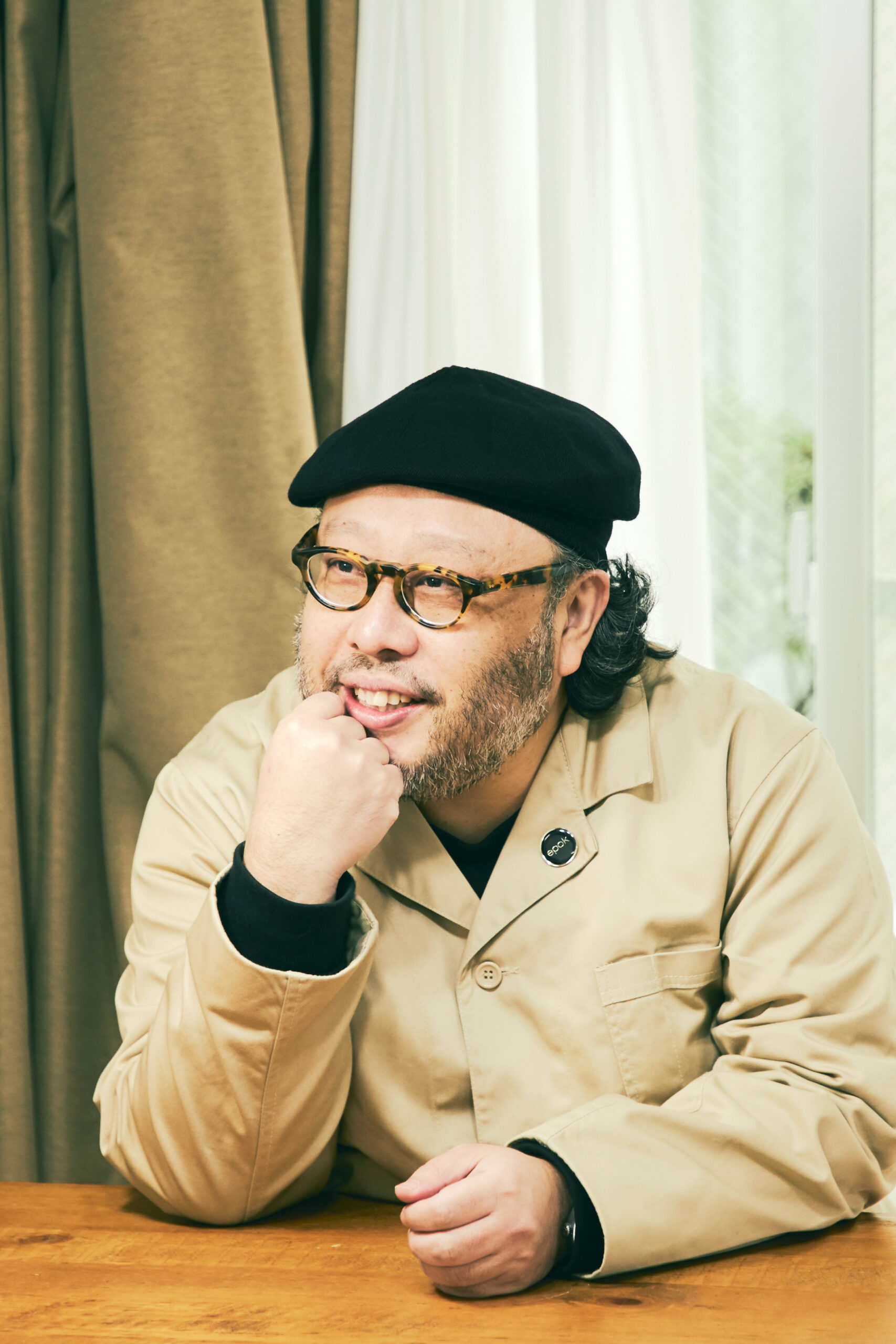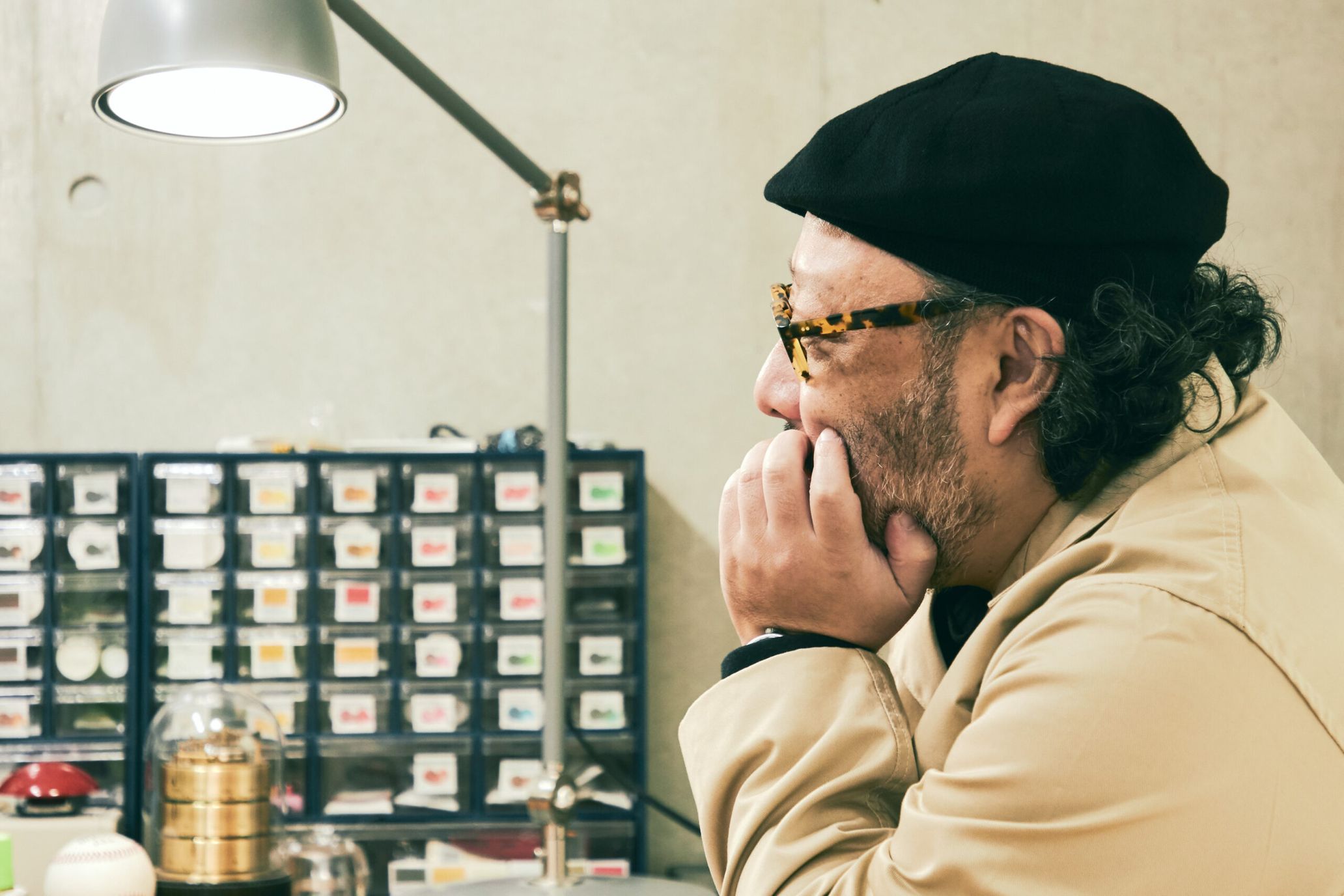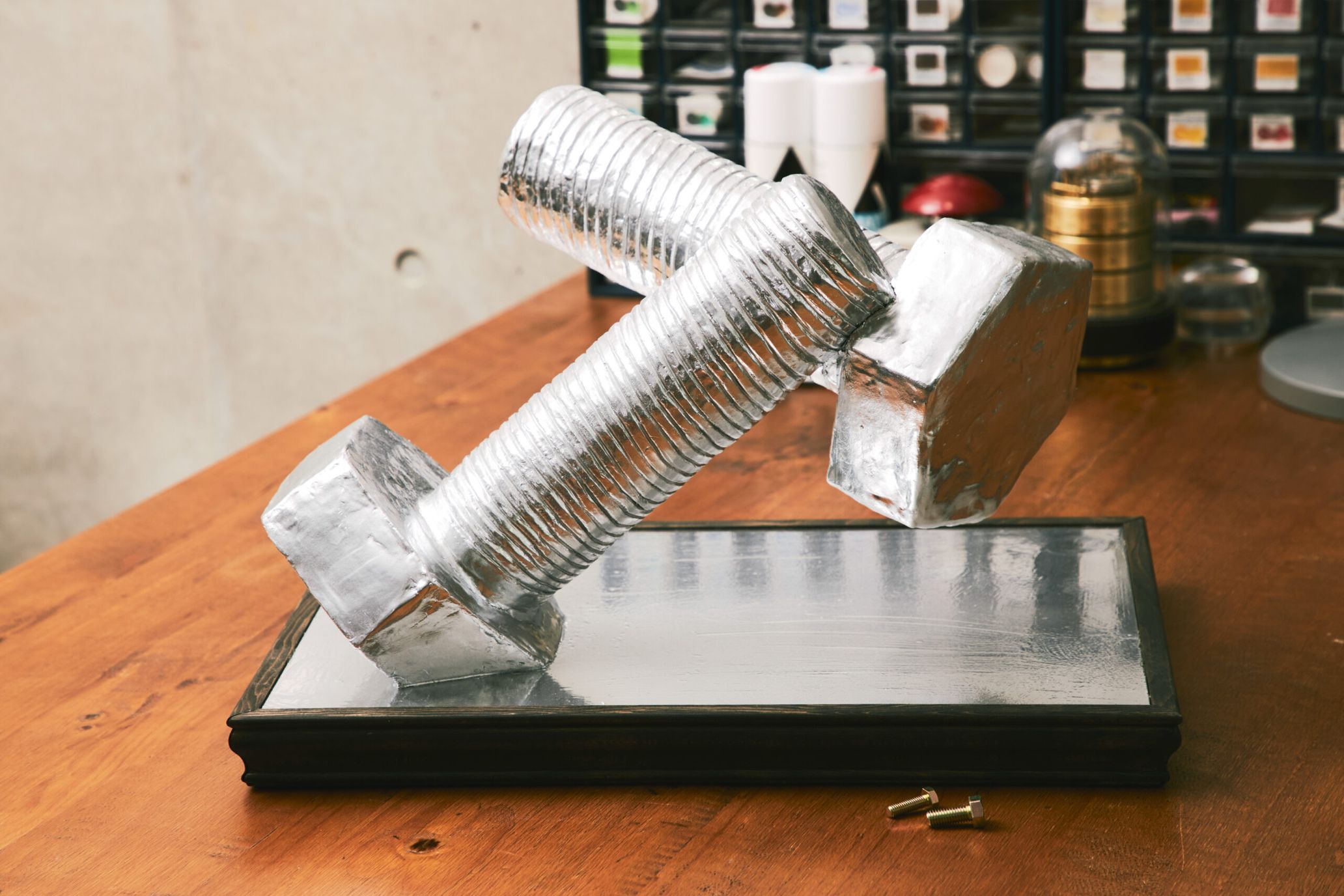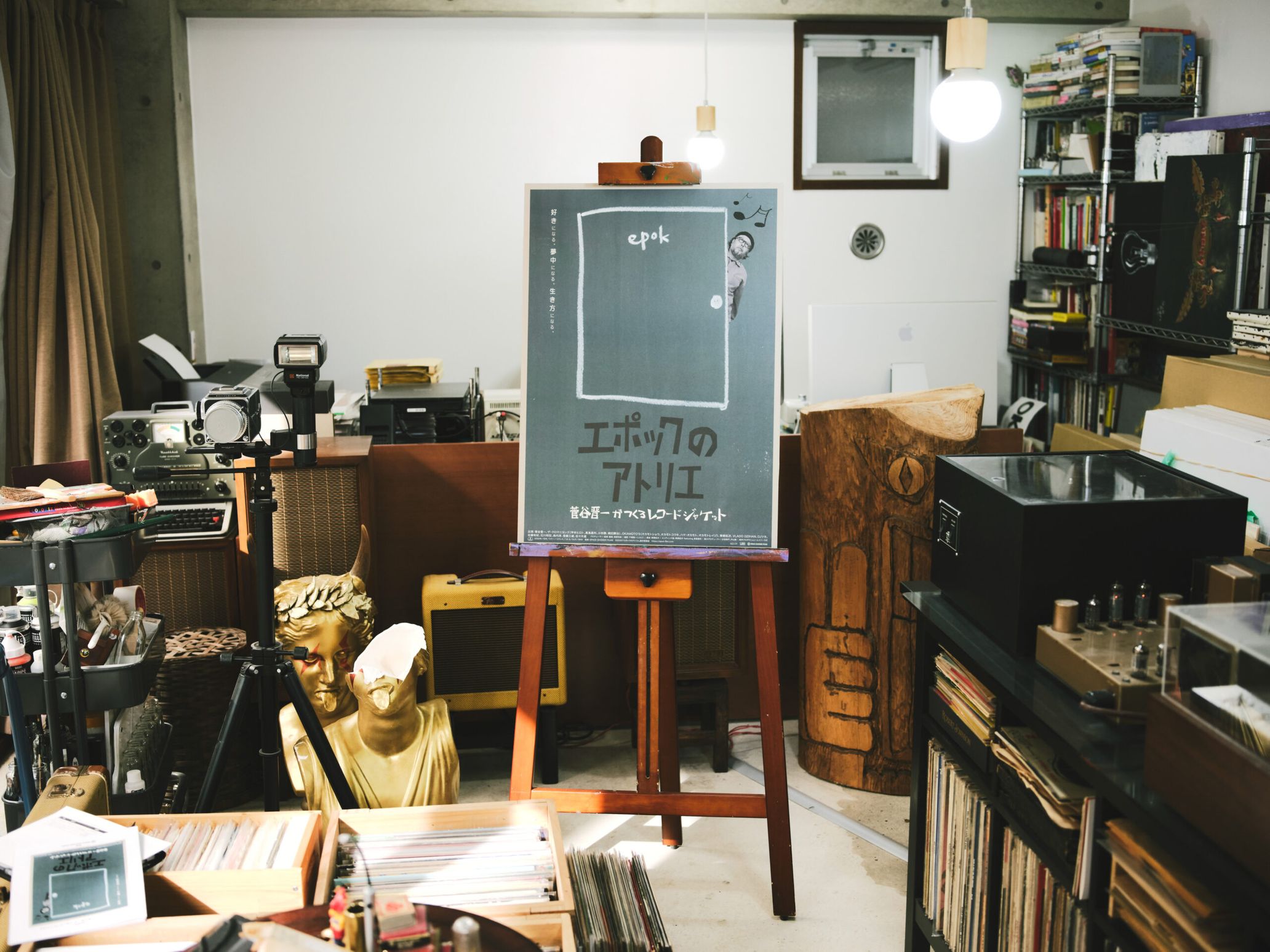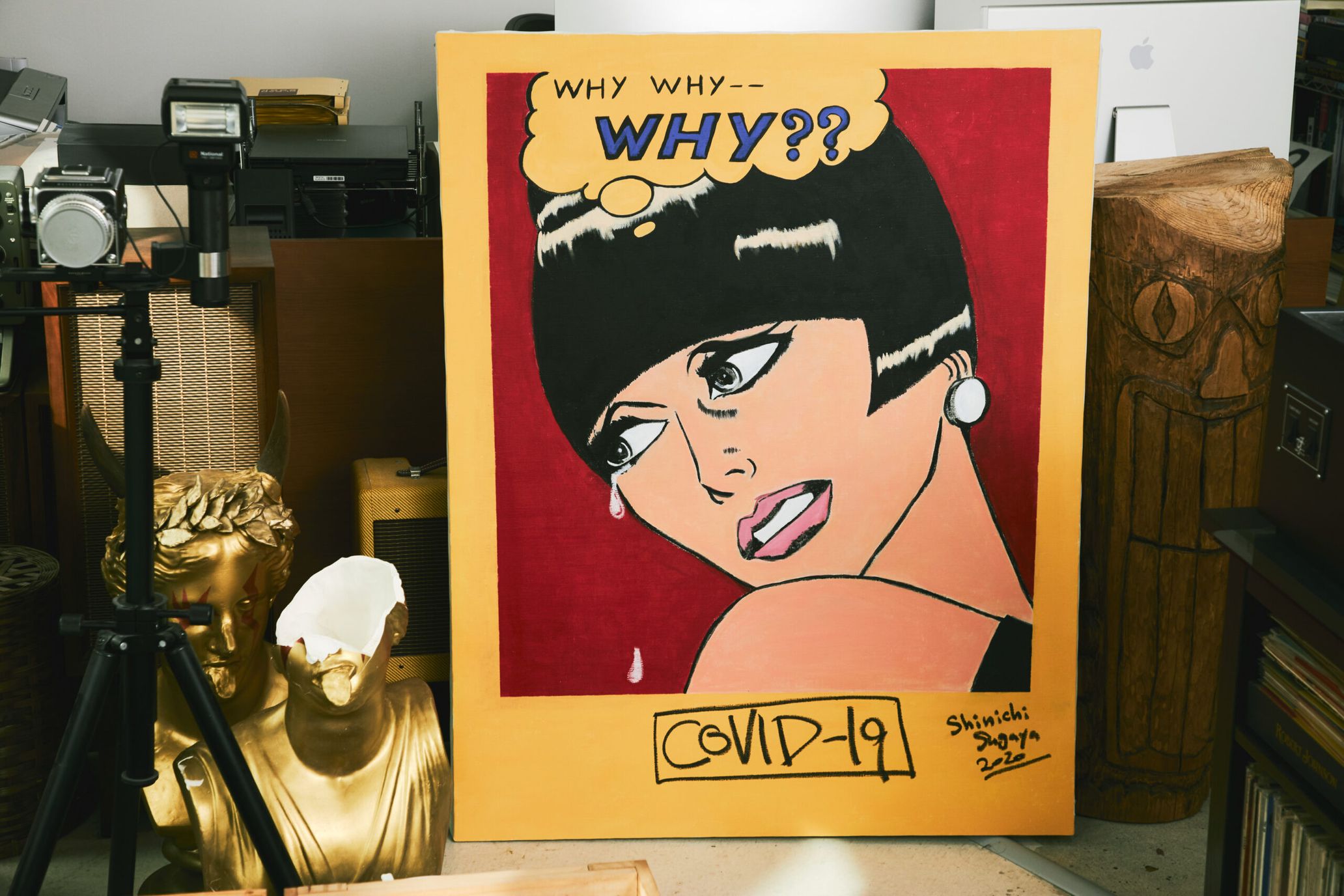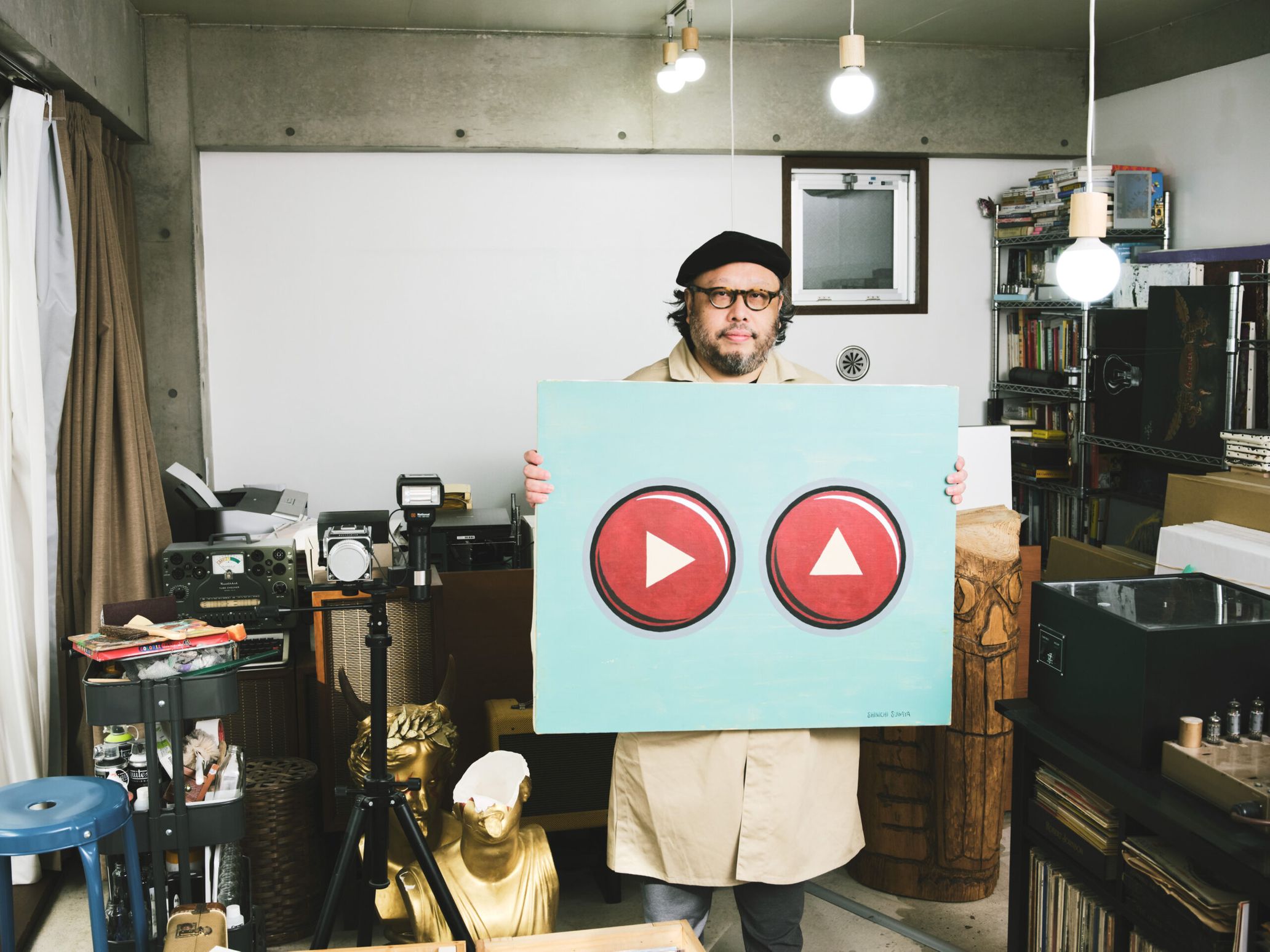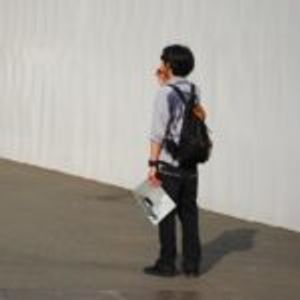Shinichi Sugaya is the designer who has done record covers for bands such as The Cro-Magnons and OKAMOTO’S. When displayed in stores, his artworks are converted into 2D, yet they are originally a one-and-only art piece that Sugaya crafts completely on his own, by various ways including drawing, sculpting, taking photos, wood-block printing, and collaging. The documentary film that captures his creative process—epok’s atelier—is playing now in theatres. In this interview, Sugaya reveals his unique world of designing that is born from his love of music.
It could’ve been anything—I just wanted to have a music-related job
――Why did you take the offer of the documentary film, where your skills might get exposed?
Shinichi Sugaya (Hereinafter Sugaya): It’s because people around me have been telling me, “your crafting style is unique,” so I thought it would be interesting to see myself working from a bird’s-eye-view.
――There are different types of designing—how did you become interested in designing for cover arts?
Sugaya: Ultimately, I’ve been a pure fan of music. When I was little, I went to Sanyo’s cassette tape factory for the school field trip, and I remember getting an empty raw tape as a souvenir. Later, I handed that tape to my friend’s older brother, and he gave it back to me with many western songs.
I was especially blown away by Run D.M.C. and Aerosmith’s “Walk This Way,” and since then I became obsessed with mainly western rock music. I was listening to Guns N’ Roses, the blues that strongly influenced popular rock bands back in the day, New York and British punk music, and so many more.
――So, as you got into western music, you consequently got into cover arts?
Sugaya: When I was a kid, there were 7-inch records as well as 8-inch CD singles, and the media forms were constantly changing in a wide variety. As I was collecting them, the shelf started to look cluttered with various patters, but I liked how it looked.
――Out of the many, what is the most remarkable cover art?
Sugaya: I’d say The Rolling Stones’ Exile on Main St. Robert Frank, who took the photo of the cover, had a different approach than other photographers; not only would he take pictures, he also drew on negative and slide films. Inspired by his style, I started from photography and later acquired other design techniques.
――When did you decide to become a designer?
Sugaya: I started thinking seriously about becoming a designer when I was in college. However, I had no knowledge of it what-so-ever. I even thought that there was a designing section in a record company, where they made cover arts. One day, I saw Mitsuo Shinzo making an appearance in the media, and that’s when found out about professional cover art designers. I was strongly impacted by Mr.Shinzo’s cover arts as they were exceptionally different from others.
――In college, you had studied architecture, right?
Sugaya: Originally, I wanted to be an architect, yet I was also studying design architect in college, and hung out with designer friends. Eventually, I became a designer, but my experiences in college have come in handy.
Architects are required to think critically about the fundaments of people’s lives, and when choosing colors for cover arts, you also need to carefully observe the colors of the walls and shelves in record stores, where the products are going to be displayed, and contrive to make it stand out from others.
――In the movie, you also mention about the time you succeeded your family’s business. Later, you applied for a job at Bonjour Records (a retail store popular among music and fashion mavens) and began pursuing your career earnestly as a designer. By the way, I heard you applied for a buyer job, is that right?
Sugaya: It could’ve been anything—I just wanted to have a music-related job. However, I still wanted to be involved in designing as well, so for the interview, I made a portfolio of the imaginative cover arts I had been making.
After all, the portfolio helped and I got a design job, but if they had asked me, “can you work as a buyer?” I would’ve still said, “yes!” I was inexperienced with designing as well, but all I needed was the responsibility to finish what I had started. In other words, you just need to “pay off your bluff,” in the end. [laughs] The most important thing is to just do it.
I listen to music without any judgment, and value how much it moves me
――Again, I would like to hear about the process of making a cover art—first, you start from listening to the tracks in the record, right?
Sugaya: That’s right. I soak up music like a sponge and think of ways to portray the ideas I squeeze out from it.
――Music is intangible, but I think it’s made visible by cover art designs. What are the things that make a connection between music and design?
Sugaya: I’m not sure. But I guess, there’s nothing but a sensation. As the word itself, it’s whatever your heart senses. It’s about how well you can maintain the emotional needle that injects excitement and happiness to your heart. That’s why I listen to music without any judgment and value how much it moves me.
――In your daily life, do you keep your mind open?
Sugaya: When I’m not crafting, I just zone out. [laughs]
――For example, do you get inspired by music playing in record/CD stores?
Sugaya: I don’t randomly get inspired from music that isn’t work-related. However, I do wonder sometimes like, “what kind of cover art do they have for this song?” No doubt, I’m a music freak. [laughs]
――Your most representative work is the artwork you’ve done for The Cro-Magnons. I was amazed that you were responsible for the entire design. In other words, they gave all the work to you.
Sugaya: That’s right. In the movie, I use the term “Oogiri (the joke battle of presenting witty answers to given topics,)” to convey the situation of my clients looking forward to what I come up with—It’s really a blessing.
――How did you build that trustful relationship with them?
Sugaya: I think it was already there. With most designers, when they are commissioned to make cover arts, they would probably present multiple design options. On the other hand, I only create and deliver one art. I don’t give options. [laughs]
The first time I worked with the guys from The Cro-Magnons was when I designed the logo for HAPPY SONG RECORDS. That led to the next, and when THE HIGH-LOWS needed a photo of a horse for the cover of their album—Do!!The★Mustang—they were like, “why don’t we have Sugaya to take a picture of it.” Though, I can imagine them talking haphazardly like, “he’ll probably get some dope stuff for us, don’t you think?” [laughs] and expecting me to come up with an elaborate response. So yes, the Oogiri joke battle was happening all along.
――Do you seek to live up to the expectations of your clients and fans? Or do you focus more on what you want to achieve? Which feeling is stronger?
Sugaya: It’s both. But actually, my desire to create what I want might be slightly stronger. Because I intend to spark guffaws with my creations. [laughs]
――So, you’re saying that “laughter” is an essential element in your crafts?
Sugaya: Yes, it’s imperative. For example, in Rakugo (a traditional performing art of humorous storytelling in Japan,) idiocy is a vital factor. It’s about adding one futile thing to accentuate silliness. For the cover art of The Cro-Magnons’ Punk, I could’ve simply drawn the illustration on a canvas. Yet, I thought it would be funnier to make it into a 3D object. It could just be for my delectation. So, for me, it’s important to add “stupidity that entices laughter.”
――It’s quite a big object.
Sugaya: I don’t really pay attention to sizes. The pipe that I used happen to be that size. [laughs] The statue in the cover of Jungle 9, is also two meters tall, although at the end it only had to be the size of a record and CD cover. The loud pieces undeniably came from sheer stupidity. [laughs] I would spare no effort for things like that. To sound cool, I only create things that make me satisfied. I’m sure most craftsmen feel the same way.
――For some of your artworks, you’ve drawn with wooden chopsticks and G-pen. Do you change tools and mediums for each piece?
Sugaya: Basically, I can draw with any mediums. Obviously, I’ve used normal brushes for my works before, but they are easy to manipulate and that’s not exciting to me. Yet, if I use different tools like chopsticks, I would be able to draw quirky lines that I couldn’t have imagined. Also, while drawing, the paper would rip, and the ink would smear—but they are all just part of the idiocy. I’m wanting these dumb things to happen. [laughs] Because of the stupid accidents, in the end I would always think, “ah, that was fun,” and a laughter is born inside of me.
――Tell me about your point of view and dedication towards both analogue and digital designs.
Sugaya: The concept of designing has changed since Mac came into the market.
The work of designing used to be divided among people; for example, one person would take pictures, and another would develop designs with the photos. However, with Mac, all the work can be done by one person. I’ve been going analog, but there are also designs that can only be achieved with digital technologies—so, it’s naturally for me to implement both systems.
However, I’m daunted by digital designs, and that’s maybe the reason why I’m not quitting crafting with my hands. I like to enjoy the inconveniences of waiting for the ink to dry, accidently distorting into a bizarre shape, and so on. I’m a digital native myself, yet I’m anxious about these conventional art forms getting blurred.
――For example, would you say you value your works because they cannot be made by copying-and-pasting?
Sugaya: In the end, it’s a one and only piece, and I guess, that matters a lot to me. Every spring, I get emails from people wanting to work for me, and most of them present illustrations drawn with their tablets. I simply reply to them with a piece of advice, “you should draw it on paper and keep it.”
――As shown in the movie, you always begin by sketching on a sheet of paper.
Sugaya: I sketch so that the ideas in my head don’t disappear. First, I receive the record and listen to it once or twice; during the process, I note down words or sketch to remember that first “BANG!” in my head. The initial impact is especially important to me.
――There are also a lot of scenes, where you fall asleep.
Sugaya: That’s also another important way to remember the ideas. The computer is flooded with information and shows too much. So, I close my eyes and set up an environment for myself to recall what first came to my mind. I tend to fall asleep, but when I wake up, the ideas are usually solidified.
――Other than drawing, creating and designing, you’ve also invented an original story of the unknown creature named Yoshio Takahashi, that appears in The Cro-Magnons’ cover art. Would you say that type of storytelling is another vital factor in your work?
Sugaya: That character was born naturally. The titles of The Cro-Magnons’ albums don’t have any meanings to them. I wouldn’t have come up with the story if they did have meanings; I’d say the story was inadvertently created.
I had been thinking that people who have been buying all The Cro-Magnons’ albums would understand the story of Yoshio Takahashi. However, I found out that they weren’t understanding at all. [laughs] But I also realized that it’s funnier that way. As a matter of fact, there were people developing their imaginations of the character and giving him random names. So, I’ve decided to develop my own story of the character and share it in the movie, so that people can compare and see if their stories of the character are anywhere close to mine. Though, my story is not the answer, and I want the people to freely imagine and enjoy the creative process.
――What’s your work style with OKAMOTO’S?
Sugaya: It’s the same as with the others. I take the finished canvas art and deliver it to them like, “here’s what I made this time!” I personally like the artwork I made for their album, Opera: I portrayed my own interpretation of “rock opera,” which is the concept of the album.
――What does the band, OKAMOTO’S mean to you?
Sugaya: They are cool, skilled and, moreover, they’re fun!
――How about The Cro-Magnons?
Sugaya: They’re awesome! That’s all I can say. In the beginning, when I first worked with THE HIGH-LOWS and listened to their music, I felt the same essence as that of the western music that I grew up listening to. I had been thinking that listening to records was the best way to enjoy music, until I started working with them. I learned the joy of live shows through their live performances. Even now, as The Cro-Magnons, they are upgrading that joy.
Through the film, I felt grateful for all the encounters and interactions
――I feel like the relationships between bands, record labels and managements, are more than just business associates. What do your clients mean to you?
Sugaya: It’s hard to explain in words. As I mentioned earlier, before watching the movie, I was merely curious to see myself making artworks from a bird’s-eye-view. But furthermore, after watching the movie, I felt grateful for all the encounters and interactions. It reminded me how blessed I am.
――The shooting started before the pandemic, but has Covid affected your work at all?
Sugaya: Not really with my crafting job. Regarding my position, I don’t think it’s necessary for me to change anything under the circumstance. I’m not sure what the future looks like, but deep down, I’m probably not wanting to change.
――By the way, aside from creating commissioned pieces, do you ever make inspirational artwork for yourself?
Sugaya: During the isolation period, I drew only one Covid-related illustration. I drew a picture of an American comic book panel, and added the thought bubble, “Why??” as in, “why can’t musicians perform live shows?” and “how come entertainments need to be suspended?” In the beginning, I didn’t draw the tears, but I added them later in tribute to Ken Shimura, who has passed away. At the same time, I also added, “COVID-19,” simply because I wanted to. Other than this piece, I’m always creating some sort of artwork for myself. The ideas for my personal pieces are often reflected in the commissioned artworks.
――Are there any styles and techniques you would like to try in the future?
Sugaya: There are a lot of techniques and mediums I want to try out. I also want to create a large-sized piece.
――I would love to have a chance to see your artworks up close.
Sugaya: I want to do my own exhibition. It might be difficult now due to Covid, but one day, I would like for people to see my actual artworks. Yet, I can already imagine how stupid accidents would happen—like, not being able to carry out the enormous piece made in the atelier. [laughs]
Shinichi Sugaya
Born in Tokyo on March 30th, 1974. He renders visuals in various ways from drawing, creating objects, wood-block printing, photography, collaging, to directing films. In the atelier of epok, he crafts alone, working for a variety of genres, such as music, bookbinding, fashion, corporate identity, and visual identity. The documentary film that closely covers his creative process, epok’s atelier, is now playing in theatres.
http://www.epok.tv
https://epok-film.com
Photography Tetsuya Yamakawa
Text Analog Assassin
Translation Ai Kaneda

